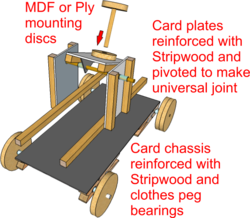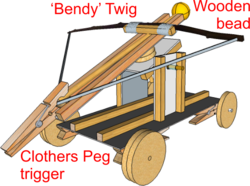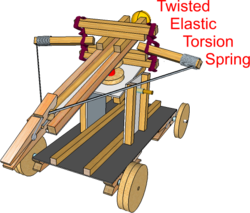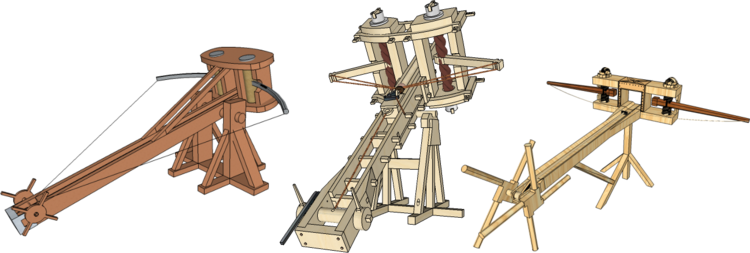Ballista: Difference between revisions
From DT Online
mNo edit summary |
mNo edit summary |
||
| Line 5: | Line 5: | ||
=====Introduction===== | =====Introduction===== | ||
The [https://en.wikipedia.org/wiki/Ballista '''Ballista'''] ''(plural Ballistae)'' were similar to giant [https://en.wikipedia.org/wiki/Crossbow '''Crossbows'''] but instead of being powered by '''[[Tension]]''' when drawing back a bow, the Romans developed into a more powerful '''[[Torsion]]''' device by pulling back on levers set into twisted skeins of rope, hair, or sinew. | The [https://en.wikipedia.org/wiki/Ballista '''Ballista'''] ''(plural Ballistae)'' were similar to giant [https://en.wikipedia.org/wiki/Crossbow '''Crossbows'''] but instead of being powered by '''[[Tension]]''' when drawing back a bow, the Romans developed it into a more powerful '''[[Torsion]]''' device by pulling back on levers set into twisted skeins of rope, hair, or sinew. | ||
Latest revision as of 13:38, 22 March 2018
Introduction
The Ballista (plural Ballistae) were similar to giant Crossbows but instead of being powered by Tension when drawing back a bow, the Romans developed it into a more powerful Torsion device by pulling back on levers set into twisted skeins of rope, hair, or sinew.
The design was based on a huge dart or javelin throwing machine but could easily be modified to shoot rocks for example. The Ballista would loose projectiles with great force along a flat trajectory. The Romans developed them to have range of as much as 460m but their effective combat range was much shorter. Different size Ballistae were built, some smaller versions were called a Scorpions (they would ‘sting’ the enemy) and others were capable of being mounted on the top of a Siege Tower
The Ballista was highly accurate and generally believed they would have been used mainly as anti-personnel weapons, or to destroy light structures, whereas less accurate weapons such as an Onager, could hit reinforced wood or heavy masonry with more force by ejecting heavier munitions.
Stripwood Model Ballistae
Model Ballistae can be made using Stripwood Technology techniques with card and 8mm x 8mm square timber. Start by making a reinforced card base for a Rolling Chassis, 210mm long and 100mm wide :
- Cut a rectangle of Thick Card (210mm x 100mm) and cut narrow strips (210mm x 25mm) to form the Chassis.
- Hold strips of timber in a small Clamp-on Vice and cut to length of 210mm using a Junior Hacksaw - these will be used to stiffen the Chassis.
- If the Ballista is to be put on a wheeled chassis, clothes pegs can be used as wheel bearings (see the DT Online article Rolling Chassis for other ways to make the Ballistae mobile).
- Reinforce three card plates, 75mm x 50mm, and pivot them together with dowel and PVC tube spacers to create a Universal Joint as shown, and mount it to the centre of the card Chassis with the 210mm lengths of Stripwood.
Safety Point! Use a Cutting Mat and a metal Safety Ruler when using a knife to cut card
Ballistae could throw large javelin type ammunition or a heavy stone (i.e. a Stone Bow). Early versions were powered by Tension (i.e. as a Long Bow). This was replaced by Torsion power provided by twisted rope or sinew.
Model Tension Ballista
- Cut a rectangle of thick card, 210mm x 30mm wide, and reinforce it with lengths of Stripwood glued along each long edge.
- Glue a 75mm long piece of Stripwood across the reinforced card 50mm from one end as shown (glue 30mm x 30mm triangles of medium thickness card over each join to strengthen them).
- Add a clothes peg to the other end of the card as a release trigger.
- Find a 'bendy' twig or length of thin cane to make the bow and bind it to the Stripwood cross piece with cotton and glue.
- Use cotton and glue also to bind either thin string or a wide elastic band across the ends of the bow.
- Make javelin type ammunition from a length of Dowel with a wooden bead or polystyrene ball for example, glued on the end.
Model Torsion Ballista
- Start with a rectangle of thick card reinforced with lengths of Stripwood as for a Tension Ballista and add a clothes peg trigger.
- Pack up one end of the Stripwood reinforcements on the main body by adding two 75mm lengths on top from the front end as shown.
- Glue together 100mmand a 75mm lengths of Stripwood and add them as cross pieces top and bottom (glue 30mm x 30mm triangles of medium thickness card over each join where they cross the main body to strengthen them).
- Wrap wide elastic bands around the ends of cross piece, insert two 75mm long stub arms then twist the elastic bands to make the Torsion spring (i.e. one end at a time, lift the elastic band off cross piece ends, twist it and replace).
- Use cotton and glue to bind either thin string or a wide elastic band across the ends of the stub arms.
- Make javelin type ammunition from a length of Dowel with a wooden bead or polystyrene ball for example, glued on the end.
Safety Point! Make Javelins from Art Straws or Dowel blunted with a wooden bead on its end for example - NEVER use anything sharp or heavy
More Model Ballistae
Model Ballistae can be developed further by adding a Winch with a Ratchet and Pawl to pull back the bow.
Activity: Find out about Roman Siege Equipment (e.g. Vinea, Pluteus, Mantelet, Testudo, Musculus, Helepolis, Turris, Corvus, Ballista, Onager, Mangonel, Trebuchet, Aries (Battering Ram) and construct a working model or models using Stripwood Technology.
Safety Point! Take great care with hot glue guns and all hot-melt glues. The melted glue can stick to the skin and cause severe burns.
















